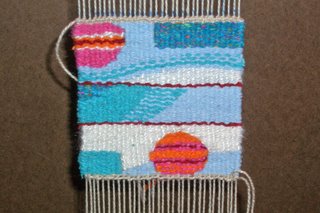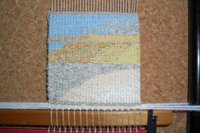The High Values - Retrospective
 I have finished my first tour of the high value yarns in my study of value. High values are the light values. It is easy to remember which is which if you think of music - - if you play the real high notes they sound light in comparison to the real low notes which sound somber and dark.
I have finished my first tour of the high value yarns in my study of value. High values are the light values. It is easy to remember which is which if you think of music - - if you play the real high notes they sound light in comparison to the real low notes which sound somber and dark.These are the keys that the Impressionists such as Claude Monet, Edgar Degas, Alfred Sisley and Camille Pissarro used. Their paintings captured the outside and the feeling you get when you are outside with the sun shining on your face or the mist along your cheek.
I can see a lot of uses for this key. In landscapes it is the snow on a sunny day, an ocean sparkling from a setting sun or the sun breaking through the fog or haze. Using it for a still life of delicate objects, perhaps a vase of wildflowers, I could create a soft and romantic mood with pale values and soft diffused light coming from a nearby window. In a portrait, it would be quite useful to portray youth, innocence, gentleness and grace.
HIGH MINOR
Colors: only high value colors
Emotions: peacefulness, delicacy, fragility, tenderness, softness, purity
Variations:
I) use unsaturated colors - - more whisper like
ii) use very dull colors - - more subtle
iii) use clear bright colors - - more lighthearted
The high minor uses all high value colors so there is no big contrast and from a distance it appears less interesting than other keys. The subtle contrasts are only visible up close. It appears airy and light - - like a whisper. Viewed in color, the small subtleties of contrast show up...in grayscale it almost disappears.
HIGH MAJOR
Colors: predominately high value with some mid value and very dark accent
Emotions: positive energy
Variations: use lots of bright colors - - for a happy, boisterous feeling
The High Major extends the high minor palette to include colors from the entire range but maintains the dominance of the light values. A very dark is used for accent only. All major keys evokes boldness, strength and assertiveness.





